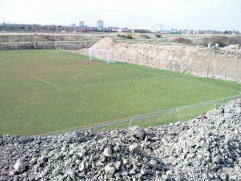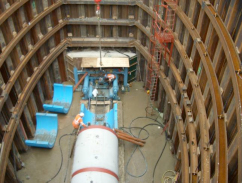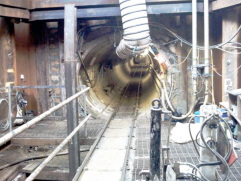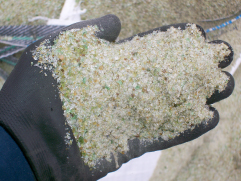Harefield to Southall Gas Pipeline ProjectWinner of a CEEQUAL Outstanding Achievement Award 2011 for Waste Management |
|
Whole Project Award
Project Team:
Client: National Grid
Design & Construction: Murphy Pipelines Ltd
The project
To meet rising gas demand in West London, Murphy Pipelines Ltd was contracted by National Grid to construct an underground, high-pressure, steel pipeline between Harefield and Southall in Middlesex. Operating at 27 bar, the 18.5-km, 1200-mm-diameter pipeline became operational in December 2009.
As well as providing the additional peak capacity necessary to meet licence conditions, the pipeline strengthens security of supply for customers in West London by ending their reliance on a single source of high-pressure gas supply.
The pipeline route is characterised by rural, low-lying, agricultural farmland in the north around Harefield. The route corridor becomes increasingly developed to the south as it extends through urban centres of Uxbridge, Ickenham, Hillingdon, Yeading and Southall. The land use along the pipeline is mixed and includes agricultural land (permanent pasture), sites designated for nature conservation, recreational land, areas of made ground, transport infrastructure and urban settlements. The land use has changed considerably over the years due to increasing urban development.
The pipeline crosses 14 roads, two railways and a canal. Although environmentally sensitive areas were avoided during the routing exercise, the pipeline also crosses five locally designated sites, ten protected hedgerows, a golf course and three rivers. Disturbance to these features was avoided by constructing three tunnels (2.5km), eight pipejacks and 28 auger bores rather than using an open-cut technique.
A number of other environmental and social challenges were managed during the construction of the pipeline. This included potential disturbance to a number of protected species such as bats, badgers, great crested newts and skylarks.
The pipeline crosses contaminated ground at its Southall end and a number of significant archaeological finds were discovered during preliminary investigations. It was important to have excellent relations with local residents, many of whom were affected by the construction of the pipeline.
Sustainable construction
Environmental sustainability was an important consideration in the design, planning and construction of the pipeline. Land use remained largely unaffected as a result of the pipeline and reinstatement of the route. However, extensive consultation with all stakeholders was carried out at an early stage to ensure acceptance and build confidence amongst those affected by the works.
An Environmental Impact Assessment was carried out by Black & Veatch. All recommendations made in the Environmental Statement and commitments agreed with consultees were tracked through to completion to ensure the impact of the project was kept to a minimum. A number of sustainable practices were implemented over and above the requirements of the Environmental Statement. A sustainability manager was assigned to the project at the construction phase to advise on the development of these practices.
Sustainable waste management
One of the most significant environmental impacts of the Harefield to Southall Pipeline project was the production of approximately 35,000 tonnes of waste from tunnelling works. Innovative ways of re-using tunnel spoil were found, so none of this material was taken to landfill.
Waste spoil, consisting mostly of Blue London Clay, was excavated from three tunnels over a distance of 2.5km. The largest tunnel in Southall was 976 metres, constructed up to 21 metres beneath ground, with a drive site adjacent to Hayes Gate Football Club. The football pitch was built on an old Victorian bottle dump. Over the years, glass fragments had made their way to the surface, often leading to injuries. Rather than dispose of the clay, planning permission was sought to cap the adjacent football field and a sustainable drainage system was installed on the site.
Tunnel arisings from adjacent drive site at Hayes Gate FC |
By capping the pitch at Hayes Gate Football Club, the project saved landfill disposal costs as well as approximately 1,500 lorry movements and their associated carbon emissions. This win-win solution to an environmental problem was also very popular with the local community.
Designing out carbon emissions
A carbon calculator was developed to understand the impact of the project on climate change. This included calculating the embodied carbon associated with the raw materials for the pipeline and the techniques used to construct it.
The project team made design changes to the shafts necessary to construct the deep tunnel, pipejack and auger bore crossings under roads, rivers, railways and a canal. Rather than using more traditional rectangular piled shafts or concrete segmental ring shafts, elliptical alternatives were constructed where feasible. By acting in compression, a rigid structure is provided without the need for steel struts that are part of the standard rectangular design. Lighter frames and smaller pile section lengths were also used.
An estimated carbon saving of around 3,500 tonnes was achieved by reducing the amount of concrete and steel needed as a result of the alterations to the design.
|
Use of sustainable infill materials
Tunnel annulus filling on the pipeline route required approximately 8,500m3 of fill material for 2,900 metres of tunnel and pipejacks. Cement grouting is the traditional method used for this, but this comes at a high price environmentally and financially. After assessing other options, the design team used sand to fill the large diameter tunnels on the project. As well as being cheaper to buy and work with, the embodied carbon associated with its production is 60 times less than that of grout.
|
A recycled glass product called EcoSand was also considered as an innovative and more sustainable alternative to sand. Enough of this product was available to fill the annulus of the eight pipejacks constructed. The carbon saving is equivalent to that of sand, but with the added benefit of making use of a waste product instead of a non-renewable resource.
|
Being quicker to install, this technology represented a 10-week saving on the project programme, as well as saving 5,000 tonnes of embodied carbon and being a cheaper alternative to cement grout.
Environmental mitigation and enhancement
Where environmental impacts were unavoidable, the project team considered mitigaton and enhancement measures that would be suitable for the local environment and accepted by the local community and other stakeholders.
The River Pinn, Yeading Brook and Grand Union Canal were crossed utilising trenchless techniques with intrusive construction works set back from the river’s edge. This avoided any direct impact on the river corridor. The approach ensured that no quantities of sediment mobilised during the works entered the watercourse.
In consultation with the Environment Agency, the project team carried out environmental improvements at the River Pinn, not normally associated with open-cut crossing methods. Although not a consent condition, the work was deemed appropriate to improve the state of a watercourse that has suffered from a proliferation of invasive species and poor biodiversity.
The River Pinn channel was narrowed to concentrate low flows in order to increase flow diversity and aid a cleaner gravel bed. Wet berms were constructed to increase emergent and marginal vegetation and steep banks were graded and re-profiled with biodegradable matting to improve the habitat either side of the river.
Flow deflectors were installed and gravel added to the riverbed to create riffles and help oxygenate the water. Finally, a backwater wetland feature was created to allow the river to connect with its original flood plain, and a range of aquatic and riverbank species were planted using native seed.
The environmental enhancement work was commended by the Environment Agency.
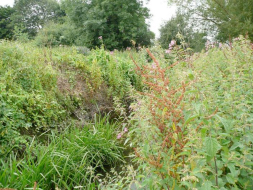 |
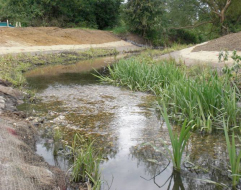 |
Before and after works at the River Pinn |
|
Moving beyond compliance is an important consideration when constructing large civil engineering projects and helps gain acceptance amongst increasingly well-informed stakeholders, as well as building company reputation. The above examples show that significant environmental, financial and commercial benefits can be achieved by planning for more sustainable alternatives to traditional designs.
For further information about this project please contact: John Trounson, senior project manager, National Grid.


